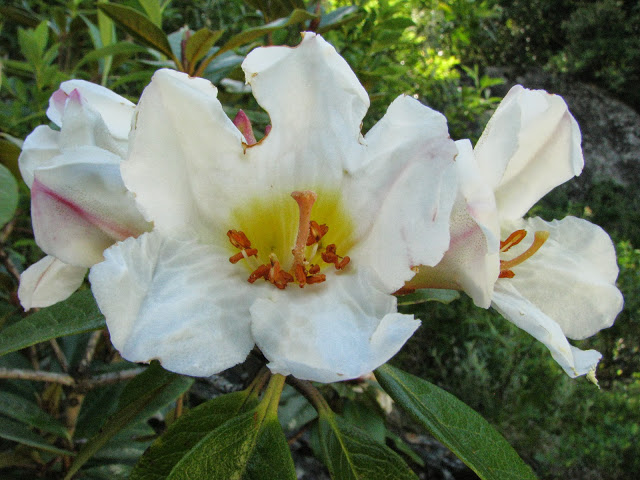Thick-stalked rhododendron
(Rhododendron pachypodum)

Description
“Pet poisonous” – Toxic parts: entire plant Rhododendron pachypodum is a species of flowering plant in the heath family, Ericaceae. It is commonly known as the thick-stalked rhododendron due to its robust stem structure. This species is native to the Himalayan region, specifically found in Bhutan, India, and Nepal, at elevations ranging from 2,800 to 4,500 meters. Rhododendron pachypodum is a highly sought after ornamental plant, popular for its attractive flowers and foliage. This article will explore the various aspects of this beautiful plant, including its taxonomy, physical characteristics, cultivation requirements, and uses. Taxonomy The scientific name of Rhododendron pachypodum is derived from the Greek words "rhodon" meaning rose and "dendron" meaning tree. The specific epithet "pachypodum" is a Latin word that translates to "thick-footed," in reference to the plant's robust stem structure. This species was first described by Joseph Dalton Hooker in 1849, in his book "Rhododendrons of Sikkim-Himalaya." Physical Characteristics Rhododendron pachypodum is an evergreen shrub that can grow up to 4 meters in height and 2 meters in width. Its leaves are oblong, leathery, and glossy green in color, measuring around 10-15 cm in length and 4-6 cm in width. The upper surface of the leaves is smooth, while the lower surface is covered with fine hairs. The flowers of Rhododendron pachypodum are trumpet-shaped, with a diameter of around 5-6 cm. They bloom in late spring to early summer, typically in May or June. The flower color can range from pale pink to deep rose, with a white throat and a hint of yellow. The flowers are arranged in compact clusters of 4-8 blooms, located at the end of each branch. Cultivation Requirements Rhododendron pachypodum is a hardy plant that thrives in cool, temperate climates. It prefers well-draining, acidic soil with a pH range of 4.5 to 6.0. This plant also requires adequate moisture, especially during its growing season, which typically occurs from late spring to early autumn. However, it is important to avoid overwatering, as this can lead to root rot and other fungal diseases. This plant can tolerate partial shade to full sun, but it prefers a location with some shade during the hottest part of the day. It is also important to protect Rhododendron pachypodum from strong winds, as its thick stems and large leaves can be easily damaged. Uses Rhododendron pachypodum is primarily used as an ornamental plant, valued for its attractive flowers and foliage. It is a popular choice for gardens, parks, and other landscaped areas. Its flowers are also used for cut flower arrangements and other floral decorations. In addition to its ornamental uses, Rhododendron pachypodum has several traditional medicinal uses. In Bhutanese traditional medicine, the leaves of this plant are used to treat gastrointestinal disorders and respiratory ailments. The bark and roots of the plant are also used to make a traditional medicine for fever and cough. Conclusion Rhododendron pachypodum is a beautiful and versatile plant that offers both ornamental and medicinal benefits. With its attractive flowers and foliage, it is a popular choice for gardens and landscaping projects. Its traditional medicinal uses also make it a valuable resource for traditional medicine practitioners. As with any plant, it is important to provide proper care and attention to Rhododendron pachypodum to ensure its health and longevity. This includes providing well-draining, acidic soil, adequate moisture, and protection from strong winds. With proper care, this plant can thrive and provide years of enjoyment for gardeners, nature lovers, and traditional medicine practitioners alike. Overall, Rhododendron pachypodum is a fascinating and valuable species of plant that offers a range of benefits and uses. Its robust stem structure, attractive foliage, and beautiful flowers make it a sought-after ornamental plant, while its traditional medicinal uses demonstrate its value in traditional medicine practices. As such, this species is an excellent example of the many benefits and uses of plants in our natural world.
Taxonomic tree:







